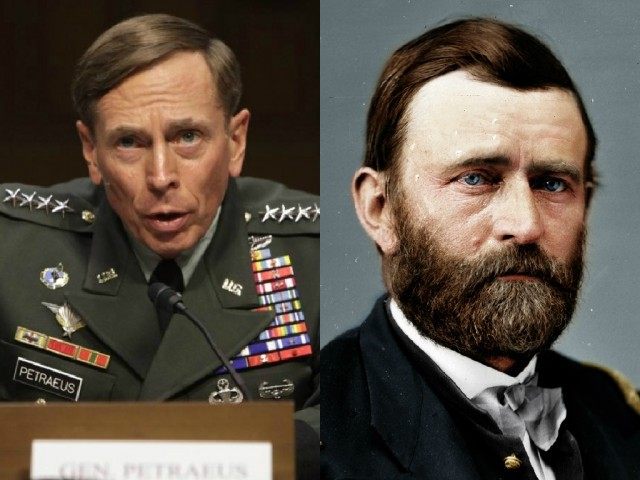Thursday, April 9, was the 150th anniversary of General Robert E. Lee’s surrender to General Ulysses S. Grant at Appomattox Court House, which marked the virtual end of the Civil War.
In New York City, the National Park Service hosted several historical presentations throughout the day and a symbolic furling of the Confederate colors at Grant’s Tomb. The Grant Monument Association (GMA), a non-profit organization dedicated to the preservation of Grant’s Tomb, closed the day’s commemorations by hosting a dinner at the Union League Club in New York City. It was a packed house. The keynote feature of the dinner was a conversation with General David H. Petraeus conducted by GMA Secretary Edward S. Hochman.
Petraeus spoke without notes, at times with visible emotion. Numerous dinner attendees afterwards expressed how impressed they were with the depth of his knowledge of Civil War history and of the obvious admiration he held for General Grant.
When discussing the nature of leadership, Petraeus highlighted Grant’s fortitude and strategic vision, attributes that particularly impressed him upon reading Bruce Catton’s Grant Takes Command, a book given to him by a historian at Ft. Leavenworth just before Petraeus deployed to Iraq to lead the Surge. Petraeus noted that following six unsuccessful Union commanders, Grant was “the first one who developed a true strategy for the North”—one that included not only a number of coordinated movements in the East, aimed at defeating Lee and his Army of Northern Virginia, but also including actions in other theaters of the war. Victory in the Civil War was not inevitable, Petraeus added; in fact, he noted that Lincoln could possibly have lost the election of 1864 were it not for General William T. Sherman’s victory in Atlanta and General Philip H. Sheridan’s victory in the Shenandoah Valley during the months leading up to the election—each of which contributed substantially to Lincoln’s re-election.
General Petraeus also recounted in vivid detail the story of Grant’s leadership at Shiloh, when Union troops were driven back—almost into the Tennessee River—on the first day of the battle. Grant spent that night under a tree in the rain because any available shelter was being used as makeshift hospitals.
Well into that night, Sherman found him in the dark. “Well, Grant,” Sherman said, “we’ve had the devil’s own day, haven’t we?”
“Yes,” Grant replied, puffing on his cigar. “Lick ‘em tomorrow though.” (Which is precisely what Grant’s army did the next day.)
General Petraeus noted the special significance of this story, which he recounted in Iraq following “a horrible day” of heavy casualties. It was during the next day’s battlefield update and analysis, which he conducted every morning. Everyone sitting in the room had “his or her shoulders slumped— literally,” he noted. He continued: “I recalled that story, and it was clearly inspirational to those in our headquarters; in fact, that led to periodic recollection of Grant’s response—‘lick ‘em tomorrow’—on some of the very tough days in the early months of the Surge.”
Grant’s fortitude truly was inspirational during many difficult moments, Petraeus asserted, recalling Grant’s spirit in the cable he sent to the secretary of war when he engaged Lee’s army in May 1864: “I propose to fight it out on this line if it takes all summer.”
And, as Petraeus reminded the audience, Grant ended up fighting it out on that line all summer, all fall, all winter, and into the following spring before the moment at Appomattox in April 1865 that we celebrated at Thursday’s dinner. Lincoln clearly had found his general, and it was great to recall some of Grant’s extraordinary qualities during Ed Hochman’s conversation with one of the most prominent and accomplished of the generals who have led our military in the wars of the post-9/11 era.
The GMA is the successor to the organization of the same name that built and administered Grant’s Tomb until it was transferred to the National Park Service in 1959. During the 1990’s, the GMA helped spearhead the monument’s restoration after it had fallen victim to desecration and neglect. More recent challenges at the site include the improvement of visitor services, including the need to expand the Tomb’s open hours, which were reduced in the wake of budget cuts. Thursday’s dinner was a success as a commemoration and as a welcome boost to the cause of preserving the memory—and the final resting place—of the hero of Appomattox.
Frank Scaturro, a partner at FisherBroyles LLP, is president of the Grant Monument Association and author of President Grant Reconsidered. Email him at frank.scaturro@grantstomb.org.

COMMENTS
Please let us know if you're having issues with commenting.